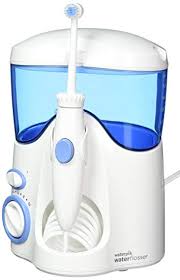At Mitchell Dentistry, we know our patients are brushing, and most are flossing. But how many are using a Waterpik? This product has been around for more than 50 years, but the new and improved version is something we believe you should not overlook when it comes to overall oral healthcare.

It is rare for us to endorse a specific brand, but we feel pretty strongly about the Waterpik Water Flosser with the reservoir. Why? From the scientific standpoint, keep in mind that plaque is a super sticky substance, the byproduct of bacterial activity in the mouth. Brushing and flossing may get some of the plaque off, but there can be damaging residue left behind. Behold the Waterpik which washes the residue right out of there.
With the Seal of Acceptance from the American Dental Association, the Waterpik® Water Flosser has been shown to:
- Help reduce plaque along the gum line and between teeth.
- Help prevent and reduce gingivitis, often a precursor to periodontal disease.
This means when used daily, as directed, the Waterpik® Water Flosser is an ideal choice for improving and/or maintaining good oral health especially in people who struggle with dental floss.
With our own patients, we have seen market improvement among our patients who use the Waterpik daily.
So how do you use the Waterpik? You fill the reservoir with warm water. At the beginning, use the light setting until you get used to it. Place the flosser in your mouth before you turn it on. Then turn it on and let the water shoot between your teeth, all the way around until the reservoir runs dry.
I personally, like to add a capful of Listerine to the warm water before I start. We checked in with the Waterpik site and here’s what they say about that:
“We recommend using warm water. Water alone is proven highly effective in numerous clinical studies. However, patients can use certain agents with the Water Flosser:
- Mouthwash – A small amount of mouthwash can be added to the water for flavoring and/or to enhance compliance.
- Chlorhexidine and Listerine – Have been clinically tested for use with the Water Flosser. CHX can be diluted in varying strengths.
Any time an agent other than water is used in the Water Flosser, flush the unit by running plain water through it afterwards.
We do not recommend bleach dilution; it shortens the life of the unit. We do not recommend pure essential oils such as tea tree oil; it destroys the product. (Formulated products that are commonly available, such as Listerine, contain essential oils in small amounts and won’t harm the product).”
We hope you will consider adding a Waterpik to your dental routine – we know you will be happy with the results.
As always, please ask us for more information or recommendations on this, or any other topic related to your oral health. Plus, we love your feedback, so feel free to send your comments our way.
All the best,
Dr. Jim